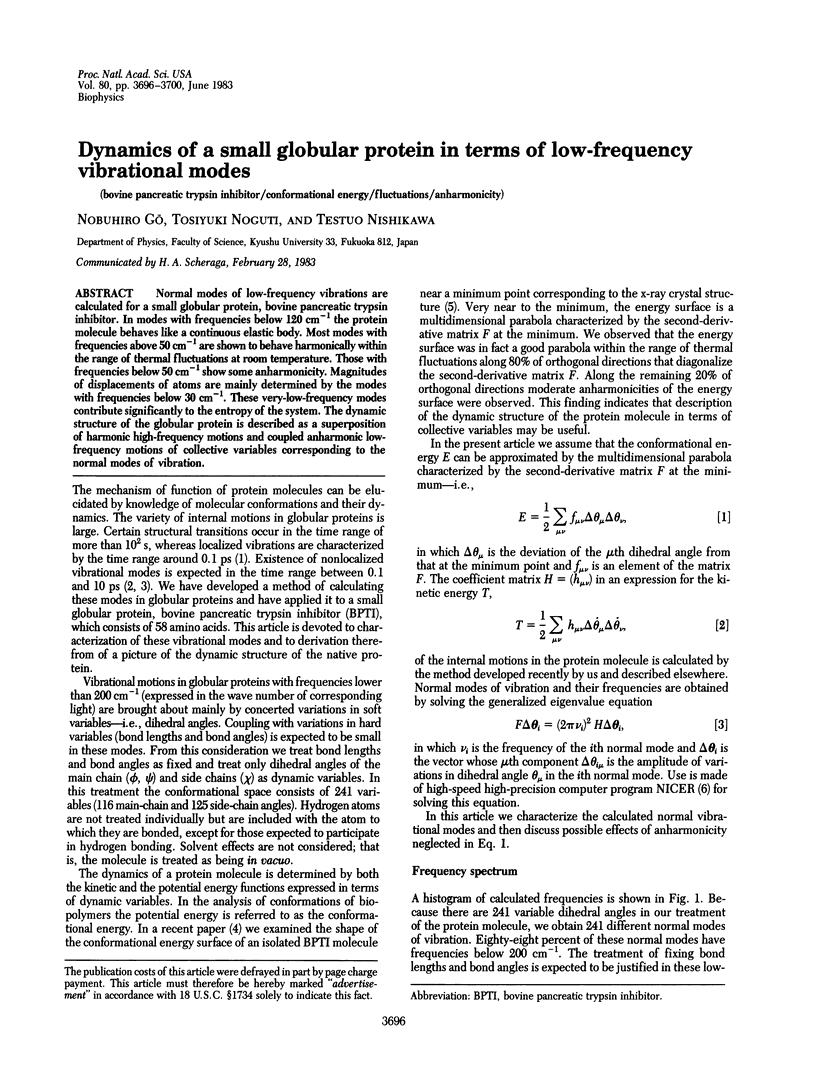Dynamics of a small globular protein in terms of low-frequency vibrational modes (original) (raw)
Abstract
Normal modes of low-frequency vibrations are calculated for a small globular protein, bovine pancreatic trypsin inhibitor. In modes with frequencies below 120 cm-1 the protein molecule behaves like a continuous elastic body. Most modes with frequencies above 50 cm-1 are shown to behave harmonically within the range of thermal fluctuations at room temperature. Those with frequencies below 50 cm-1 show some anharmonicity. Magnitudes of displacements of atoms are mainly determined by the modes with frequencies below 30 cm-1. These very-low-frequency modes contribute significantly to the entropy of the system. The dynamic structure of the globular protein is described as a superposition of harmonic high-frequency motions and coupled anharmonic low-frequency motions of collective variables corresponding to the normal modes of vibration.

Selected References
These references are in PubMed. This may not be the complete list of references from this article.
- Careri G., Fasella P., Gratton E. Statistical time events in enzymes: a physical assessment. CRC Crit Rev Biochem. 1975 Aug;3(2):141–164. doi: 10.3109/10409237509102555. [DOI] [PubMed] [Google Scholar]
- Frauenfelder H., Petsko G. A., Tsernoglou D. Temperature-dependent X-ray diffraction as a probe of protein structural dynamics. Nature. 1979 Aug 16;280(5723):558–563. doi: 10.1038/280558a0. [DOI] [PubMed] [Google Scholar]
- Hutchens J. O., Cole A. G., Stout J. W. Heat capacities from 11 to 305 degrees K and entropies of hydrated and anhydrous bovine zinc insulin and bovine chymotrypsinogen A. Entropy change for formation of peptide bonds. J Biol Chem. 1969 Jan 10;244(1):26–32. [PubMed] [Google Scholar]
- Lee B., Richards F. M. The interpretation of protein structures: estimation of static accessibility. J Mol Biol. 1971 Feb 14;55(3):379–400. doi: 10.1016/0022-2836(71)90324-x. [DOI] [PubMed] [Google Scholar]
- Mao B., Pear M. R., McCammon J. A., Northrup S. H. Molecular dynamics of ferrocytochrome c: anharmonicity of atomic displacements. Biopolymers. 1982 Oct;21(10):1979–1989. doi: 10.1002/bip.360211005. [DOI] [PubMed] [Google Scholar]
- McCammon J. A., Gelin B. R., Karplus M. Dynamics of folded proteins. Nature. 1977 Jun 16;267(5612):585–590. doi: 10.1038/267585a0. [DOI] [PubMed] [Google Scholar]
- Noguti T., Go N. Collective variable description of small-amplitude conformational fluctuations in a globular protein. Nature. 1982 Apr 22;296(5859):776–778. doi: 10.1038/296776a0. [DOI] [PubMed] [Google Scholar]
- Peticolas W. L. Low frequency vibrations and the dynamics of proteins and polypeptides. Methods Enzymol. 1979;61:425–458. doi: 10.1016/0076-6879(79)61020-0. [DOI] [PubMed] [Google Scholar]
- Shrake A., Rupley J. A. Environment and exposure to solvent of protein atoms. Lysozyme and insulin. J Mol Biol. 1973 Sep 15;79(2):351–371. doi: 10.1016/0022-2836(73)90011-9. [DOI] [PubMed] [Google Scholar]
- Sturtevant J. M. Heat capacity and entropy changes in processes involving proteins. Proc Natl Acad Sci U S A. 1977 Jun;74(6):2236–2240. doi: 10.1073/pnas.74.6.2236. [DOI] [PMC free article] [PubMed] [Google Scholar]
- Suezaki Y., Go N. Breathing mode of conformational fluctuations in globular proteins. Int J Pept Protein Res. 1975;7(4):333–334. doi: 10.1111/j.1399-3011.1975.tb02448.x. [DOI] [PubMed] [Google Scholar]
- Tasumi M., Takeuchi H., Ataka S., Dwivedi A. M., Krimm S. Normal vibrations of proteins: glucagon. Biopolymers. 1982 Mar;21(3):711–714. doi: 10.1002/bip.360210318. [DOI] [PubMed] [Google Scholar]